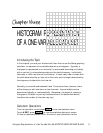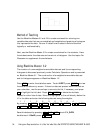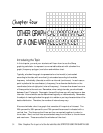
Press 2ndF STAT PLOT , touch A PLOT1, and press ENTER and a PLOT1
setup screen will appear. Turn the plot on by pressing ENTER . Select
one-variable data by pressing ▼ ENTER Set the list to L1 by pressing ▼
2ndF L1 ENTER . Set the frequencies to L2 by pressing 2ndF L2 ENTER .
Choose the histogram graph by pressing 2ndF STAT PLOT , touching A HIST,
and double touching 1 Hist.
In our example, the smallest value is 1 and the largest value is 4. The logical
intervals for the data set would be 1 (0.5 to 1.5), 2 (1.5 to 2.5), 3 (2.5 to 3.5), and
4 (3.5 to 4.5). Notice, the mutually exclusive and exhaustive intervals.
To set this viewing window, press WINDOW and set the horizontal axis to
-
.5 < x
< 5.5 (one below the smallest endpoint and one above the largest endpoint) with
Xscl = 1 (width of interval) by pressing (–) • 5 ENTER 5 • 5 ENTER
1 ENTER . Next, set the vertical axis to
-
1 < y < 5 (from one less than no data
points to at most five within the interval, which is one more than the largest
weight) with Yscl = 1 (counting) by pressing (–) 1 ENTER 5 ENTER 1
ENTER . Press GRAPH view the histogram. The following histogram will be
constructed for the data.
For Discussion
You and your students can discuss:
1. Why would you not want three or less intervals?
2. Why you might not want more than seven intervals?
3. What are some other logical interval sizes?
Additional Problems
Create the histograms for the following data sets:
1. 66 68 73 55 63 58 71 59 62
2. V
alue Frequency
120
513
10 12
Histogram Representation of a One-Variable Data Set/STATISTICS USING THE SHARP EL-9600 15


















